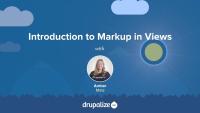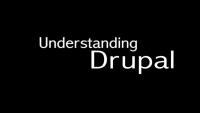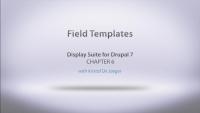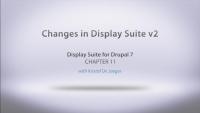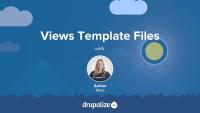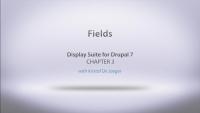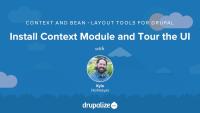In the next few tutorials, we'll pull back the veil of Views theming a bit and introduce some tools to help you wrangle Views' template files. In this tutorial, I'll introduce you to Views Theme Information and how to use this interface to find out which template files are being used to mark up your view.
Additional resources
This next set of tutorials relates to controlling markup in Drupal when using the Views module. We’ll cover:
- What affects markup in Views
- Selecting an appropriate Views display format as a starting point for markup output
- Customizing field markup
- Customizing wrapper selectors and CSS classes
- Accessing theming information in Views
- Overriding Views template files
Additional resources
Now let's shift gears and take a look at how using Panels affects markup in Drupal. I will show you some unique-to-Panels concepts as well as how to apply Drupal theming principles to customize markup on a Drupal site that uses Panels.
In the tutorials that follow, you will learn:
- About Panels layouts
- How to add CSS classes using Panels
- How to override the panel pane template file
- What Panels means by “Style”—with a broad overview of Style Plugins and where to go for a deeper dive
Additional resources
Panels — Drupal.org
Chaos Tools Suite (CTools) — Drupal.org
Theming Basics for Drupal 7 — Drupalize.Me
Drupal’s theming system gives designers complete control over how a site’s content is rendered for a web browser, and custom themes can give any site a distinctive look. But sometimes it’s useful to make minor tweaks to a site’s appearance using nothing but CSS rules. They allow designers to tweak font sizes, colors, and so on without altering the underlying HTML that defines the site’s structure. In this lesson we'll look at:
- CSS Injector module
- Explain how this works
Additional resources
Understanding Drupal
FreeLearn the essential terminology of Drupal in this overview of content nodes, blocks, theming, menu system and modules. In Understanding Drupal, the first in The Lullabot Learning Series, the Lullabot team provides an overview of Drupal as a content management system, as a PHP web application framework, and as a developer community. Its documentary-style exploration covers all the terminology and fundamental concepts for both site administrators and developers. If you've ever been confused by Drupal or are still trying to wrap your head around the community and platform, then this video is a roadmap to accelerate your journey up the Drupal learning curve. Topics include:
- How content is entered and managed
- How users and user permissions are handled
- What blocks are and what they can do
- The concepts and capabilities of Drupal's powerful module system
- How Drupal handles navigation and its menu system
- How themes alter the site layout, design, and presentation
- Site configuration and administrative messages and settings
This video uses Drupal 6 for examples, however it is more focused on general Drupal concepts rather than version-specific how-tos.
Markup in Drupal 7
CourseField Templates
FreeIn this lesson we cover how you can do some powerful things with Display Suite in regards to field templates. Using the Display Suite GUI there are lots of configurations and offerings to get the markup just the way you want.
Additional resources
In this tutorial, we'll download the Theme Developer module and use it to inspect our view when it is using view modes for display instead of fields. We'll also look at how Theme Developer interacts with Views and some of the "gotchas" that can occur when using these modules together.
Additional resources
Theme Developer — Drupal.org
Devel — Drupal.org
simplehtmldom API — Drupal.org
Legacy Site Building
GuideTaxonomy
TopicTaxonomy in Drupal provides a way to classify your site’s content. Taxonomy vocabularies are created with terms within those vocabularies.
Drupal gives you a lot of tools to move things around and arrange the functionality of your site, but often the main difference between most websites comes down to presentation. Themes are the Drupal method for controlling your site’s presentation. In this lesson we'll discuss finding a theme, and installing and configuring themes. A big part of understanding how themes can change your layout lies in understanding blocks and regions, so we'll cover what those are, and why they're important. Then we'll talk briefly about administration themes and how they are different from your main theme.
Additional resources
This lesson covers all the updates/differences in the latest 2.x version versus other Drupal 7 releases. The new 2.x version of Display Suite is still in active development at the time that this video was published, but we want to make sure you know the changes that are coming when the new version is finally released. This video is very important to view if you are using Display Suite version 2 for the first time and have watched other videos in this series. It covers UI changes/updates as well as feature differences.
Additional resources
In this tutorial, I'll walk you through how to identify a template file to override, locate the template file in your site's code base, and copy it into your active theme.
Additional resources
We've examined the Views formats and row style formatting. Now I'll walk you through the default field wrapper markup in Views. We'll inspect the default markup for fields, remove the default field wrapper markup and I'll point out some of the implications of this action, and then I'll apply a different Views format, so that you can see how the field wrapper markup is impacted by that configuration change. This will give you a better understanding of how markup is affected at the field-level in the context of a view.
Additional resources
Now that we’re familiar with the default field wrapper markup in Views, let’s explore how to customize this markup. In this tutorial, I will introduce to you a prototype of recent posts that was built using Pattern Lab. We’ll inspect the wrapper markup of two template files that compose this media list. After getting familiar with the prototype markup, we’ll apply that markup, step-by-step, to the fields in our view of recent posts. In doing so, we will use the custom field markup settings for each field and utilize rewrite results and replacement tokens to customize our markup output even further.
Additional resources
Display Suite Fields
FreeIn this lesson we cover adding different type of custom fields to your layout using Display Suite. From adding a custom code field, blocks, to dynamic fields, each of these can be moved around your layout and replicated/modified across different display modes.
Additional resources
With the main Domain Access site installed, we now need to get our other domain names added to the site and working. In this tutorial we'll review the settings for domains, add the Alumni and News domain names, and then test that all three domains are working properly.
Additional resources
Basic Domain Access module configuration (drupal.org handbook)
In this lesson we'll get started with Context by installing the module on our site, and then walking through the user interface we have to work with. We'll discuss things like conditions and reactions, and see how things are set up.
Shows how to set up private files in Drupal 7 and custom upload path as well as how to set up an image field.

